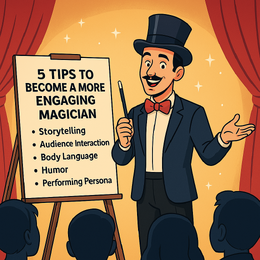5 Tips to Become a More Engaging Magician

5 Tips to Become a More Engaging Magician
Whether you're performing close-up magic, stage illusions, or mentalism, engaging your audience is key. A truly captivating magician doesn’t just amaze with sleight of hand but creates a memorable experience that leaves spectators entertained, inspired, and emotionally connected. In this post, we’ll explore five essential techniques to improve your stage presence, build stronger audience connections, and elevate your performances.
Key Points:
- The power of storytelling in magic
- How to enhance audience interaction
- The importance of body language and voice control
- Using humor and misdirection effectively
- Developing a unique performing persona
The Power of Storytelling in Magic:
A great magician isn’t just a trickster; they are a storyteller. Storytelling transforms simple tricks into compelling experiences that captivate audiences on an emotional level. By weaving a narrative into your magic, you can create a journey that enhances the mystery and makes the performance more memorable.
How to Implement Storytelling:
-
Develop a theme or storyline around your tricks. For example, a simple card trick can become an adventure about a lost king searching for his queen.
-
Use descriptive language and vivid imagery to set the scene before revealing the effect.
-
Draw inspiration from myths, personal experiences, or classic tales to create an emotional hook.
-
Structure your routine like a story—beginning, conflict, climax, and resolution—to maintain audience interest.
2. How to Enhance Audience Interaction
Magic is at its best when it’s interactive. Engaging the audience directly ensures they are part of the experience rather than passive observers. Encouraging participation also fosters a deeper emotional connection to your magic.
Ways to Boost Interaction:
-
Invite spectators to hold props, make choices, or participate in decisions that influence the trick’s outcome.
-
Ask open-ended questions that encourage engagement and curiosity.
-
React genuinely to audience responses, making them feel valued and involved.
-
Use eye contact and individual acknowledgment to make each person feel part of the magic.
-
Learn and remember spectators’ names during close-up performances to create a personalized experience.
3. The Importance of Body Language and Voice Control
Your presence on stage or in close-up settings plays a crucial role in audience engagement. Body language and vocal delivery can either enhance the impact of your magic or detract from it.
Techniques for Effective Stage Presence:
-
Use deliberate movements to direct attention and reinforce the illusion. Avoid fidgeting or unnecessary gestures.
-
Maintain good posture and exude confidence, as nervous body language can weaken the effectiveness of a trick.
-
Control your facial expressions to match the tone of the routine—whether it's amazement, suspense, or comedy.
-
Use vocal variation to create emphasis. A well-timed whisper can draw an audience in, while a sudden shift in volume can heighten excitement.
-
Master the art of pausing. Pauses create anticipation and give your audience time to absorb the magic moment.
4. Using Humor and Misdirection Effectively
Humor is a powerful tool in magic that makes performances more entertaining and helps misdirect audiences at key moments. Laughter relaxes spectators, making them more receptive to surprises and illusions.
How to Incorporate Humor and Misdirection:
-
Use lighthearted jokes or self-deprecating humor to create a warm connection with your audience.
-
Time your humor strategically—before a reveal to build suspense or after to diffuse tension.
-
Employ verbal and physical misdirection, such as gesturing towards one hand while executing a sleight with the other.
-
Play with audience expectations by setting up a predictable outcome and then surprising them with an unexpected twist.
-
Avoid over-reliance on scripted humor; be adaptable and use situational comedy based on audience reactions.
5. Developing a Unique Performing Persona
One of the most important aspects of becoming an engaging magician is developing a distinctive performance persona. Your persona defines your style, influences your audience’s perception, and sets you apart from others in the field.
Steps to Create Your Persona:
-
Identify your strengths and passions within magic—do you excel at comedy magic, storytelling, or mentalism?
-
Develop a consistent character that aligns with your personality and interests, whether it’s the mysterious magician, the comedic trickster, or the elegant illusionist.
-
Choose a signature look and mannerisms that complement your brand.
-
Craft a catchphrase, signature trick, or a recurring theme that audiences associate with you.
-
Stay authentic—your persona should be an amplified version of yourself rather than an entirely fabricated character.
Final Thoughts
Being a great magician isn’t just about mastering sleight of hand—it’s about crafting an engaging and memorable experience for your audience. By incorporating storytelling, audience interaction, strong body language, humor, and a unique persona, you can transform your magic from simple tricks into captivating performances that leave a lasting impact.
So, which of these techniques will you start focusing on first? We invite you to like and share this blog post on your own social media.
